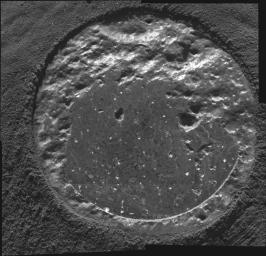
|
The Biggest Microscopic Image Ever
- Click the image above for a larger view
- Full-Res JPEG (1934 x 1862) (602.5 kB)
- Full-Res TIFF (1934 x 1862) (3.6 MB)
Caption:
This is a mosaic of four individual frames taken by the microscopic imager that have been very carefully stitched together to reveal the entire 5-centimeter-diameter (almost 2-inch) hole left on the rock dubbed "Humphrey." The holes were created by the Mars Exploration Rover Spirit's rock abrasion tool. The mosaic, created on March 7, 2004, is the first of its kind of an abraded surface on Mars, and gave scientists their first ever microscopic imager view of the entire drilled area. While it is easy for the panoramic camera and the navigation cameras to fit an area this size into their field of view, the microscopic imager can only capture a portion of the ground area with each image.
Scientists are interested in many of the small features on "Humphrey" uncovered by the rock abrasion tool and made visible by the microscopic imager. The sinuous veins within the rock could be evidence that water was trickling through the material while it was deep underground, whereas the dark "age spots" in the center of the hole may be crystals of the mineral olivine.
Cataloging Keywords:
| Name | Value | Additional Values |
|---|---|---|
| Target | Mars | |
| System | ||
| Target Type | Planet | |
| Mission | Mars Exploration Rover (MER) | |
| Instrument Host | Spirit (MER-A) | |
| Host Type | Rover | |
| Instrument | Microscopic Imager (MI) | Rock Abrasion Tool (RAT) |
| Detector | ||
| Extra Keywords | Grayscale, Water | |
| Acquisition Date | ||
| Release Date | 2004-03-09 | |
| Date in Caption | 2004-03-07 | |
| Image Credit | NASA/JPL/Cornell/USGS/Honeybee Robotics | |
| Source | photojournal.jpl.nasa.gov/catalog/PIA05523 | |
| Identifier | PIA05523 | |
